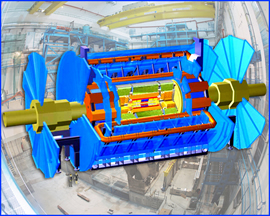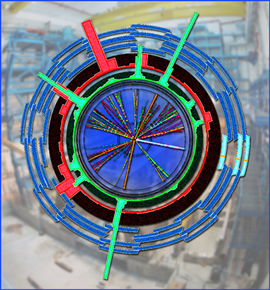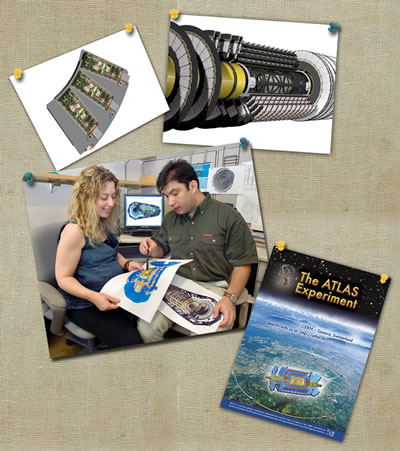

| August 27, 2004 | science beat | | lab a-z index | lab home |
 |
 |
||
|
|||
| ATLAS Reaches Out |
| Contact: Paul Preuss, paul_preuss@lbl.gov |
|
The international ATLAS collaboration — numbering 1,800 participants from more than 150 universities and laboratories in 34 countries — recently reelected Michael Barnett of Berkeley Lab's Physics Division and Erik Johansson of Stockholm University as cochairs of the ATLAS education and outreach program. Their mission is to explain to a diverse audience — "everyone from high-school students to government science ministers," Barnett says — what kinds of science the ATLAS experiment was designed to explore and how it will do its job. 
The ATLAS detector consists of an inner tracker to measure the momentum of each charged particle, a calorimeter to measure the energies carried by the particles, a muon spectrometer, and a magnet system. ATLAS is the largest of the detectors now under construction as part of the Large Hadron Collider (LHC) at CERN, the European Laboratory for Particle Physics near Geneva, Switzerland. The big proton-proton collider, a ring-shaped accelerator 27 kilometers in circumference, is not scheduled to be switched on until 2007, but when that happens, Barnett warns, watch out. "The LHC has seven times the energy of Fermilab, 14 TeV versus 2 TeV" — TeV stands for tera (or trillion) electron volts — "and even running at a fraction of its design energy, it will produce many times the number of top quarks," Barnett says. As for new discoveries, "it will see what it's going to see very fast." One of the most sought-after creatures in the particle zoo is the Higgs boson (or bosons), the particles whose interactions with other particles are thought to be responsible for their mass. Yet, says Barnett, "we actually want to downplay finding the Higgs," not because the Higgs isn't important but because "its discovery will be just one of many things we'll learn — including the completely unexpected." Among the wilder possibilities proposed by theorists is the production of copious short-lived miniature black holes, formed by the concentration of enormous amounts of energy in small spaces as the proton beams collide inside ATLAS. Rapidly evaporating black holes would announce their presence with a distinctive spray of particles. 
A simulated collision event viewed along the beam pipe. Other far-out discoveries might include extra dimensions of space. Some theorists propose that gravity is so much weaker than the other forces because these forces are confined to our familiar three-dimensional space, whereas gravity is diluted by operating in extra spatial dimensions. If so, some debris from energetic collisions inside ATLAS might vanish into these unseen dimensions, producing asymmetric patterns. Perhaps more likely, if a bit less spectacular, will be the observation of numerous "sparticles" and other new species predicted by theories of supersymmetry, or SUSY. These and other novelties will have to be recognized in a radiation storm of trillions of mostly ordinary particles emanating from the collisions of tens of millions of bunches of protons meeting head-on each second at near light-speed. Virtually every one of them will be measured and tracked through an array of detector elements in ATLAS, arranged in concentric cylinders around the beam pipe. To explain the immense — and immensely complex — experiment, the outreach team's João Pequenão is on a six-month visit from CERN's branch office in Portugal to assemble a half-hour animated reconstruction of ATLAS — detailed right down to the innermost detector's 140 million individual silicon pixels! Using computer-graphics software like that used to create Hollywood special effects, Pequenão works from detailed engineering drawings and other sources — including his own photos of the pixel-detector components developed at Berkeley Lab. Reiterating and manipulating the photos thousands of times, he gradually builds up the enormous array. When the movie is done, he says, the viewer will be able to "fly through the giant detector like a Star Wars spaceship." 
Adi Rom and João Pequenão discuss visual elements of the ATLAS animation and brochure. (Photo by Roy Kaltschmidt) Pequenão has occasionally improved upon the commercial software — "I like to write my own algorithms for some reflection and texture effects" — and he's composed his own music score as well. The finished movie will incorporate three sections, an opening overview mostly completed, the detailed look at each major component and how it works now underway, and finally a sampling of collision patterns ATLAS will be looking for in the unceasing particle storm — a characteristic Higgs-boson event, the production of supersymmetry particles, and so on — which are yet to be produced. In addition to the movie, other ATLAS outreach projects include a handsome brochure assembled by graphic designer Adi Rom, designed to get across the essentials of the experimental system and the significant areas of science it will examine in a series of iconic graphics and pithy paragraphs — so pithy, indeed, that Barnett refers to the brochure as "essentially text free." Those who want more information will find as much as they can handle on the extensive ATLAS experiment web site, including a webcam view of the cave, 200 meters underground, where ATLAS is being assembled. The photos are updated every half hour. A 19-minute, award-winning documentary film made in 2000 by a Dutch filmmaker can also be accessed from this site, but beware, The ATLAS Experiment movie has little in common with João Pequenão's sophisticated animation-in-progress — although an introductory piece of the animation already completed serves as the introduction to the website. Additional information
|
| Top |